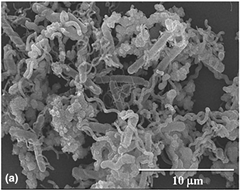Crossref Citations
This article has been cited by the following publications. This list is generated based on data provided by
Crossref.
Vaidyanathan, Settu
Cherng, Jong-Yuh
Sun, An-Cheng
and
Chen, Chien-Yen
2016.
Bacteria-Templated NiO Nanoparticles/Microstructure for an Enzymeless Glucose Sensor.
International Journal of Molecular Sciences,
Vol. 17,
Issue. 7,
p.
1104.
Atla, Shashi B.
Chen, Yen-Ju
Chiu, Hao-Wei
Chen, Chien-Cheng
Shu, Jwu-Ching
and
Chen, Chien-Yen
2016.
Microbial induced synthesis of CeCO3OH and CeO2 hollow rods micro/nanostructure.
Materials Letters,
Vol. 167,
Issue. ,
p.
238.
Hsu, Chun-Mei
Huang, Yi-Hsun
Chen, How-Ji
Lee, Wen-Chien
Chiu, Hao-Wei
Maity, Jyoti Prakash
Chen, Chien-Cheng
Kuo, Yi-Hao
and
Chen, Chien-Yen
2018.
Green synthesis of nano-Co3O4 by Microbial Induced Precipitation (MIP) process using Bacillus pasteurii and its application as supercapacitor.
Materials Today Communications,
Vol. 14,
Issue. ,
p.
302.
Dewi, Anggraeni Kumala
Sharma, Raju Kumar
Das, Koyeli
Sukul, Uttara
Lin, Pin-Yun
Huang, Yi-Hsun
Lu, Chung Ming
and
Chen, Chien-Yen
2023.
Newly-development of synthetic MnCO3 and MnO2 precipitate through biologically-induced mineralization for effective adsorption of As(V) in aqueous solution.
Environmental Technology & Innovation,
Vol. 32,
Issue. ,
p.
103374.
Dewi, Anggraeni Kumala
Sharma, Raju Kumar
Das, Koyeli
Sukul, Uttara
Lin, Pin-Yun
Huang, Yi-Hsun
Lu, Chung Ming
Lu, Cheng-Kang
Chen, Tsung-Hsien
and
Chen, Chien-Yen
2023.
Biologically-induced synthetic manganese carbonate precipitate (BISMCP) for potential applications in heavy metal removal.
Heliyon,
Vol. 9,
Issue. 5,
p.
e15919.
Taharia, Md.
Dey, Debanjan
Das, Koyeli
Sukul, Uttara
Chen, Jung-Sheng
Banerjee, Pritam
Dey, Gobinda
Sharma, Raju Kumar
Lin, Pin-Yun
and
Chen, Chien-Yen
2024.
Microbial induced carbonate precipitation for remediation of heavy metals, ions and radioactive elements: A comprehensive exploration of prospective applications in water and soil treatment.
Ecotoxicology and Environmental Safety,
Vol. 271,
Issue. ,
p.
115990.



